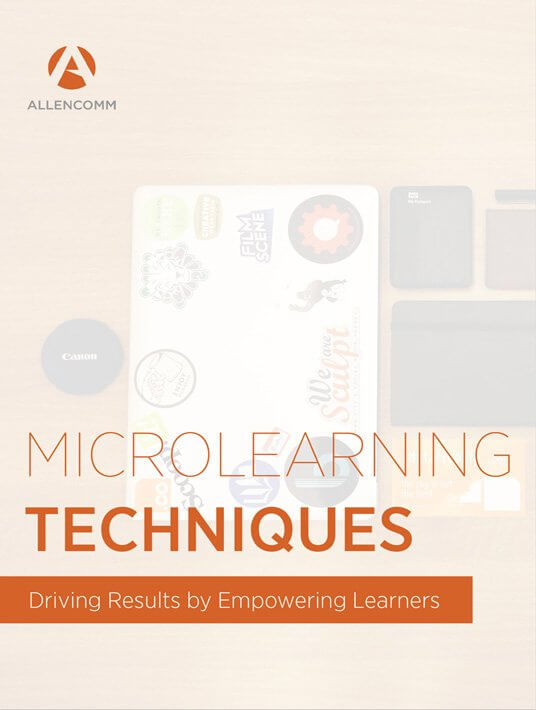Microlearning Techniques: Getting Started With Microlearning
There are 3 elements that define microlearning. With rare exceptions, these 3 criteria will positively impact your creation of training solutions. In this article we will explore these criteria, along with some critical steps for developing a successful microlearning strategy for your organization.

3 Critical Components Of Microlearning – Case Study
We’ll use the example of one of our clients, Dominos, to demonstrate how the 3 components of microlearning should be intertwined. Perhaps the characteristic most commonly thought to be essential to microlearning –brevity– is a result of the first two elements. When you ensure that a module is strategically designed to focus the activity to achieve a specific objective, you will create something shorter than traditional training.
1. Microlearning Is Targeted To A Specific Performance Objective
Microlearning is, by its nature, specific in what it is trying to accomplish. One microlearning module is aimed at introducing one concept, changing one behavior or exploring one idea – in short, it is linked to one performance objective. Dominos has created micro courses that are each targeting something specific, such as food waste reduction or a decrease in pizza remakes.
2. Microlearning Includes A Focused Learning Activity
To accomplish that specific objective, microlearning uses a single learning activity. It might be a game, a discussion, or an interactive video, but that activity is focused on just one behavior or concept. To meet their objectives, Dominos' courses were designed as games, with each game helping employees learn one aspect of how to quickly and accurately make pizza.
3. Microlearning Is Usually Part Of A Larger Strategy
Finally, microlearning does not typically exist on its own. It should be part of an organization’s broader strategy. Rather than simply slicing and dicing a 2-hour course into shorter segments, those microlearning elements should be used strategically to complement a broader learning strategy. Although Dominos' games are all microlearning courses, they contribute to a larger vision for how to improve performance and use training to support and help drive the future of the brand.
Is Microlearning Right For You?
Microlearning may be right for your organization if:
- Your company’s products or services are updated frequently,
- You are introducing new systems or processes,
- Your goal is to manage change,
- Your employees have different levels of knowledge or skills, or
- Completion rates are key to success.
However, even if microlearning will work well for your organization, don’t jump into design thinking it will also be a quicker, cheaper version of traditional training. AllenComm’s CEO Ron Zamir says “Microlearning is not so much about short versus long. It’s about distinct content pieces versus broader training”. While microlearning is great for flexibility and agility, being able to create great, targeted content can take just as much or more development time than longer, but broader, training. At AllenComm, we find microlearning especially helpful for customer education and change management projects. Because of client and learner needs, we now have microlearning or micro elements in roughly 70% of our projects, up from 20% just five years ago.
4 Steps For Developing A Microlearning Strategy
Use these 4 steps to guide your development of a microlearning strategy.
If you’re new to microlearning, Ron recommends starting with a prototype that can provide a “wow factor”. A successful first microlearning initiative will help you obtain buy-in for future projects. It's also a best practice to manage microlearning content outside your Learning Management System – perhaps on a website or portal that can be used on other systems. Doing so will allow you to use Google Analytics to gather data to demonstrate the return you’re getting on your investment. And you will get a return on that investment. Whether you have a small budget for a simple series of short discussion activities or a larger budget for more complex content like games and interactive videos, microlearning can drive results by empowering your employees with the access to and control over information they want in a 21st-century workplace.
- Assess.
Assess your organization’s needs and determine what behaviors you are trying to change with microlearning. - Evaluate.
With which courses or modules are your learners typically less engaged? What specifically is causing this disengagement? - Map.
Choose a design that can be used in a variety of different ways and for a variety of topics. Broad applicability can save time and money. - Define.
What are your budget, timeframe and internal resources? Invest more on the initial design, because you will probably reuse it later.
If you want to know more about microlearning, download the free eBook Microlearning Techniques: Driving Results By Empowering Learners now.
Related Articles
- Free eBook – Microlearning Techniques: Driving Results By Empowering Learners
- Microlearning Techniques: Understanding The Learning Lifestyle








